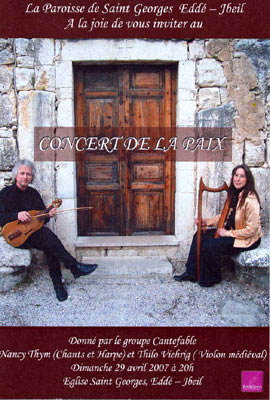Aktuelles
CANTEFABLE Peace Concert - Concert de la Paix - Friedenskonzert
Sunday, April 29, 2007 8pm
Eglise Saint Georges, Edde, Byblos (Jbeil), Lebanon

CANTEFABLE voice, harp, hammered dulcimer, vielle d' arco (medieval fiddle), rebec
Cante
for the music, which enchants the spirit
Fable for the story, which delights the wit
"Cantefable" is a term from the Middle Ages for a story which is partly spoken and partly sung or accompanied by music. CANTEFABLE's programs are a blend of stories and music which transport the listener to magical times and places.
PEACE CONCERT Medieval Songs of Love and Adoration to Harp and Vielle
Music builds bridges. The musicians of the Middle Ages travelled freely through many lands and their music was influenced by the musical cultures they experienced. King Alfonso of Spain (1252-1284) was called "El Sabio" ("the Wise") because he employed Islamic, Christian and Jewish musicians at his court. His collection of songs about the miracles of the Virgin, the "Cantigas de Santa Maria", reflect the influence of all three. Oswald von Wolkenstein (1377-1445) often used French melodies for his songs written in Old German.
The troubadours and minstrels, who performed primarily at the courts of nobility, sang mostly of love, faithfulness and adoration. In the profound symbolism of the Middle Ages these can not be interpreted as love songs in the modern sense, however. They were often an expression of deep faith, a model for behavior or a reflection of utmost devotion to the Virgin Mary. At the same time the songs also express a sense of humor and an almost ecstatic joy. Spanish songs to the Virgin Mary are particularly characterized by the influence of Arabian rhythms. The songs in the German language often have very sophisticated texts filled with symbolism and double meaning.
Harp and vielle are often shown being played together in depictions from the Middle Ages. With medieval harp, vielle, rebec and hammered dulcimer, CANTEFABLE plays, sings and tells the stories of songs from the Codex Buranus ("Carmina Burana", 13th c.), the Notre Dame School (13th c.), the Jenaer Liederhandschrift (13th - 14th c.), the Cantigas de Santa Maria (13 th c.), the Codex Engelberg (ca. 1400), and by Hildegard von Bingen (1098-1179), the 12th century troubadours and Oswald von Wolkenstein (1377-1445), etc.. Particularly pleasing is the blend of harp, voice and vielle in the 2 and 3 part songs.
The musicians from CANTEFABLE also travel through many lands performing medieval music from many cultures. Their goal is to promote understanding through music as ambassadors of peace.